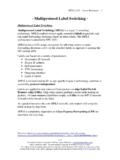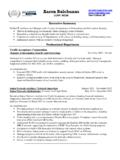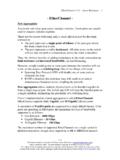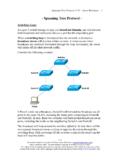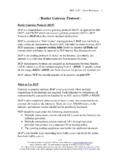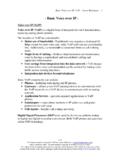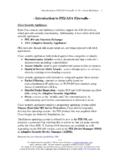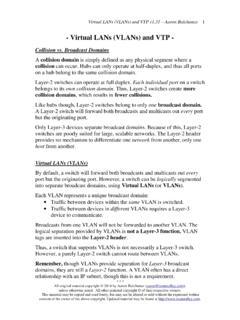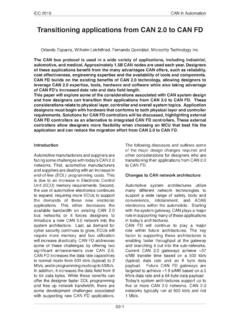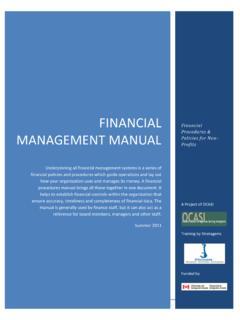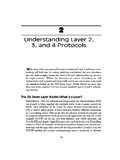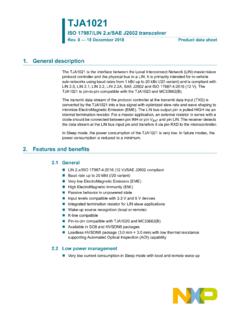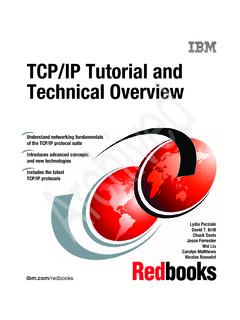Transcription of OSI Reference Model - Router Alley
1 OSI Reference Model Aaron Balchunas * * * All original material copyright 2012 by Aaron Balchunas unless otherwise noted. All other material copyright of their respective owners. This material may be copied and used freely, but may not be altered or sold without the expressed written consent of the owner of the above copyright. Updated material may be found at 1 - OSI Reference Model - Network Reference Models A computer network connects two or more devices together to share information and services. Multiple networks connected together form an internetwork. Internetworking present challenges - interoperating between products from different manufacturers requires consistent standards. Network Reference models were developed to address these challenges. A network Reference Model serves as a blueprint, detailing how communication between network devices should occur.
2 The two most recognized network Reference models are: The open Systems interconnection (OSI) Model The Department of Defense (DoD) Model Without the framework that network models provide, all network hardware and software would have been proprietary. Organizations would have been locked into a single vendor s equipment, and global networks like the Internet would have been impractical, if not impossible. Network models are organized into layers, with each layer representing a specific networking function. These functions are controlled by protocols, which are rules that govern end-to-end communication between devices. Protocols on one layer will interact with protocols on the layer above and below it, forming a protocol suite or stack. The TCP/IP suite is the most prevalent protocol suite, and is the foundation of the Internet.
3 A network Model is not a physical entity there is no OSI device. Manufacturers do not always strictly adhere to a Reference Model s blueprint, and thus not every protocol fits perfectly within a single layer. Some protocols can function across multiple layers. OSI Reference Model Aaron Balchunas * * * All original material copyright 2012 by Aaron Balchunas unless otherwise noted. All other material copyright of their respective owners. This material may be copied and used freely, but may not be altered or sold without the expressed written consent of the owner of the above copyright. Updated material may be found at 2 OSI Reference Model The open Systems interconnection (OSI) Model was developed by the International Organization for Standardization (ISO), and formalized in 1984.
4 It provided the first framework governing how information should be sent across a network. The OSI Model consists of seven layers, each corresponding to a specific network function: 7 Application 6 Presentation 5 Session 4 Transport 3 Network 2 Data-link 1 Physical Note that the bottom layer is Layer 1. Various mnemonics make it easier to remember the order of the OSI Model s layers: 7 Application All Away 6 Presentation People Pizza 5 Session Seem Sausage 4 Transport To Throw 3 Network Need Not 2 Data-link Data Do 1 Physical Processing Please ISO further developed an entire protocol suite based on the OSI Model ; however, the OSI protocol suite was never widely implemented. The OSI Model itself is now somewhat deprecated modern protocol suites, such as the TCP/IP suite, are difficult to fit cleanly within the OSI Model s seven layers.
5 This is especially true of the upper three layers. The bottom (or lower) four layers are more clearly defined, and terminology from those layers is still prevalently used. Many protocols and devices are described by which lower layer they operate at. OSI Reference Model Aaron Balchunas * * * All original material copyright 2012 by Aaron Balchunas unless otherwise noted. All other material copyright of their respective owners. This material may be copied and used freely, but may not be altered or sold without the expressed written consent of the owner of the above copyright. Updated material may be found at 3 OSI Model - The Upper Layers The top three layers of the OSI Model are often referred to as the upper layers: Layer-7 - Application layer Layer-6 - Presentation layer Layer-5 - Session layer Protocols that operate at these layers manage application-level functions, and are generally implemented in software.
6 The function of the upper layers of the OSI Model can be difficult to visualize. Upper layer protocols do not always fit perfectly within a layer, and often function across multiple layers. OSI Model - The Application Layer The Application layer (Layer-7) provides the interface between the user application and the network. A web browser and an email client are examples of user applications. The user application itself does not reside at the Application layer - the protocol does. The user interacts with the application, which in turn interacts with the application protocol. Examples of Application layer protocols include: FTP, via an FTP client HTTP, via a web browser POP3 and SMTP, via an email client Telnet The Application layer provides a variety of functions: Identifies communication partners Determines resource availability Synchronizes communication The Application layer interacts with the Presentation layer below it.
7 As it is the top-most layer, it does not interact with any layers above it. ( Reference : ) OSI Reference Model Aaron Balchunas * * * All original material copyright 2012 by Aaron Balchunas unless otherwise noted. All other material copyright of their respective owners. This material may be copied and used freely, but may not be altered or sold without the expressed written consent of the owner of the above copyright. Updated material may be found at 4 OSI Model - The Presentation Layer The Presentation layer (Layer-6) controls the formatting and syntax of user data for the application layer. This ensures that data from the sending application can be understood by the receiving application. Standards have been developed for the formatting of data types, such as text, images, audio, and video.
8 Examples of Presentation layer formats include: Text - RTF, ASCII, EBCDIC Images - GIF, JPG, TIF Audio - MIDI, MP3, WAV Movies - MPEG, AVI, MOV If two devices do not support the same format or syntax, the Presentation layer can provide conversion or translation services to facilitate communication. Additionally, the Presentation layer can perform encryption and compression of data, as required. However, these functions can also be performed at lower layers as well. For example, the Network layer can perform encryption, using IPSec. OSI Model - The Session Layer The Session layer (Layer-5) is responsible for establishing, maintaining, and ultimately terminating sessions between devices. If a session is broken, this layer can attempt to recover the session. Sessions communication falls under one of three categories: Full-Duplex simultaneous two-way communication Half-Duplex two-way communication, but not simultaneous Simplex one-way communication Many modern protocol suites, such as TCP/IP, do not implement Session layer protocols.
9 Connection management is often controlled by lower layers, such as the Transport layer. The lack of true Session layer protocols can present challenges for high-availability and failover. Reliance on lower-layer protocols for session management offers less flexibility than a strict adherence to the OSI Model . OSI Reference Model Aaron Balchunas * * * All original material copyright 2012 by Aaron Balchunas unless otherwise noted. All other material copyright of their respective owners. This material may be copied and used freely, but may not be altered or sold without the expressed written consent of the owner of the above copyright. Updated material may be found at 5 OSI Model - The Lower Layers The bottom four layers of the OSI Model are often referred to as the lower layers: Layer-4 Transport layer Layer-3 Network layer Layer-2 Data-Link layer Layer-1 Physical layer Protocols that operate at these layers control the end-to-end transport of data between devices, and are implemented in both software and hardware.
10 OSI Model - The Transport Layer The Transport layer (Layer-4) does not actually send data, despite its name. Instead, this layer is responsible for the reliable transfer of data, by ensuring that data arrives at its destination error-free and in order. Transport layer communication falls under two categories: Connection-oriented requires that a connection with specific agreed-upon parameters be established before data is sent. Connectionless requires no connection before data is sent. Connection-oriented protocols provide several important services: Segmentation and sequencing data is segmented into smaller pieces for transport. Each segment is assigned a sequence number, so that the receiving device can reassemble the data on arrival. Connection establishment connections are established, maintained, and ultimately terminated between devices.

